
In anticipation of this week's event, Publish Or... bracket [GOES SOFT], we are showcasing a piece from the book each day this week. We hope to see you this Thursday!
GROUNDING: Landslide Mitigation Housing
Jared Winchester / Viktor Ramos
“Landslides and other ‘ground failures’ cost more lives and money each year than all other natural disasters combined, and their incidence appears to be rising. Nevertheless, the government devotes few resources to their study — and the foolhardy continue to build and live in places likely to be consumed one day by avalanches of mud.”
- Brenda Bell, The Atlantic Monthly, (Jan. 1999)
Precarious relationships between human occupation and geophysical metamorphism are a common occurrence along coastal California and Los Angeles County in particular. The architecture of this region is a perpetual game of chance between tranquil domesticity and the danger of its tragic upheaval. To mitigate future catastrophic events, salvage currently unbuildable landscape, and to evolve an architectural vernacular of dwelling within tight topographic settings - a network of soil stabilizing housing units will be positioned within the fragile sub-strata of the Rancho de Palos Verdes community. This area is the site of an ancient landslide condition that was reactivated by the development of poorly conceived housing communities in the 1950’s. Already existing technologies used to stabilize slopes in extreme conditions, such as soil nails and helical piles are adapted into a “stitched” foundation system for houses that allows a home to be tethered to its site rather than rigidly fixed to a ground condition.
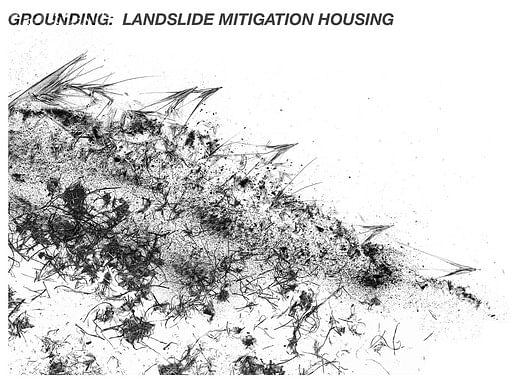
Image: Conceptual drawing interpreting an assemblage of raw matter into a hillside scene.
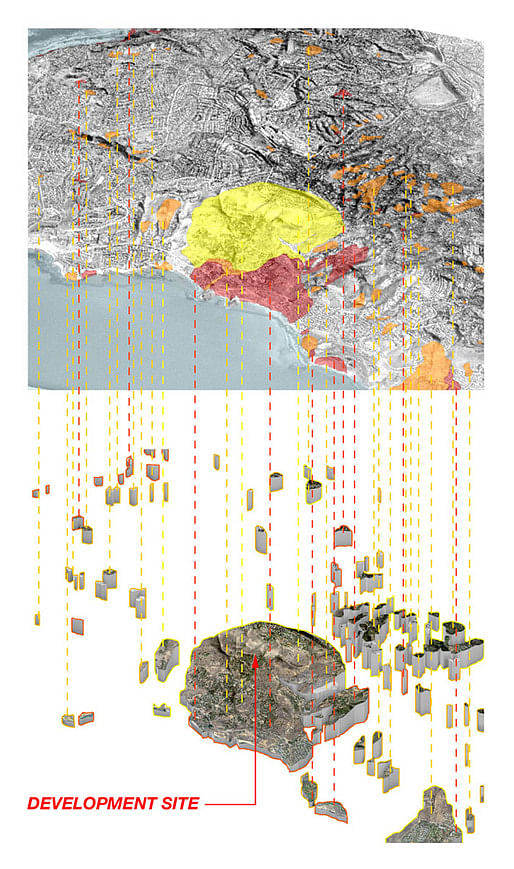
Image: Selecting sites of intervention comes from an analysis of a landslide inventory map. Certain areas of landslide activity within Palos Verdes Peninsula are currently closed to any future development or building alterations. These areas will become sites for deployment of the new GROUNDING vessels.

Image: Site Plan of unit locations within active areas of ground movement and nearby endangered settlements.

Image: Hillside perspective of landslide mitigation housing units.
Like lighthouses perched along the edge of a shoreline as an orientation and warning device, these new grounding vessels are poised along threatened slope contours to act as a safeguards for the community below as well as indicative instruments that behaviorally convey information on the geological and hydrological processes occurring below grade. Since soil movement is a natural, regenerative mechanism of the area’s geologic procession, the homes do not eliminate earth flow, they simply slow down and make visible the ongoing processes in the topography. The houses predictably align themselves to the former pathways laid out by a previously abandoned development and initially take on the rhythm of a typical cookie-cutter suburban community. However, as the inevitable subsidence in the landscape affects the position and posturing of the vessels, the development will take on a more organic composition that expresses its profound relationship to the site’s geology. These houses will bulge, grip, and posture themselves to act as a drag upon the force of the advancing slope movements. In the process of slowing down and deterring landslide activity, the spatial conditions of the homes and the position of specific rooms will be altered.

Image: Kinetic Floorplan and performative characteristics.

Image: Kinetic plan diagram.
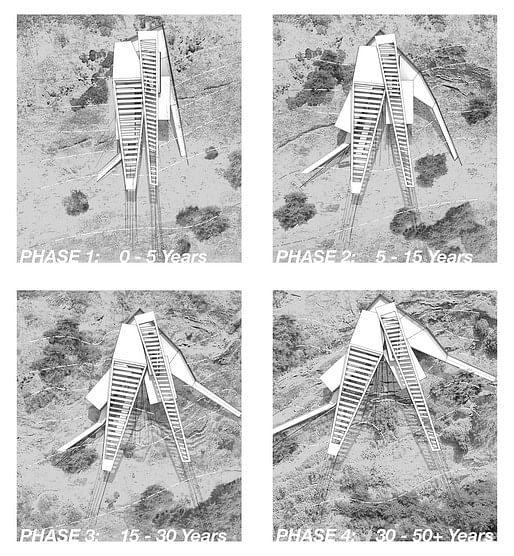
Image: Time-Lapse of unit and site morphologies.

Image: Sections through a typical unit.
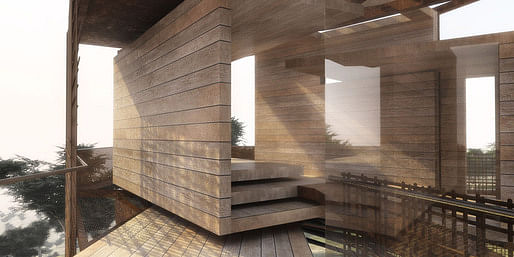

Image: Juxtaposition of the houses' spatial conditions provide feedback as to what type of soil transformation is occurring.
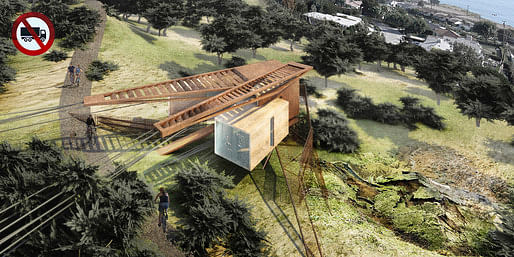
Thus, the new landslide mitigation housing development acts as a performative infrastructure - echoing its specific location’s changing slope characteristics. Spatial and architectonic information become synonymous with scientific readings of ground surface displacement, soil saturation and pressure. The design is thought of as a basic prototype that could be scaled to larger sized homes, and it is hoped that the basic strategies for implementation can be imported to other unstable site conditions in areas around the world.
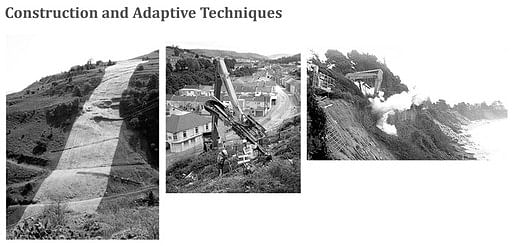
Image: Construction techniques for deployment of landslide mitigation units.
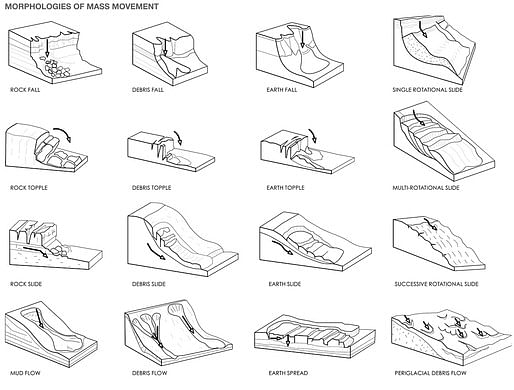
Image: Morphologies of mass movement were analyzed in terms of their behavioral characteristics.
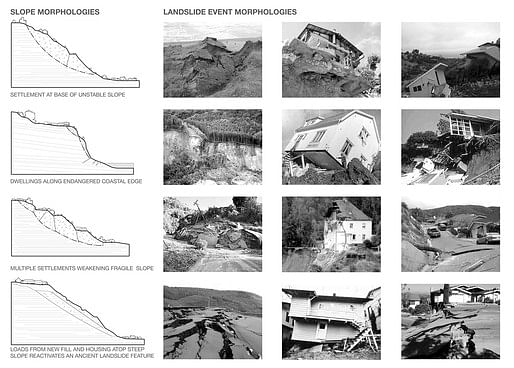
Image: The ways in which statically conceived architecture fails gives clues as to new types adaptive building techniques.
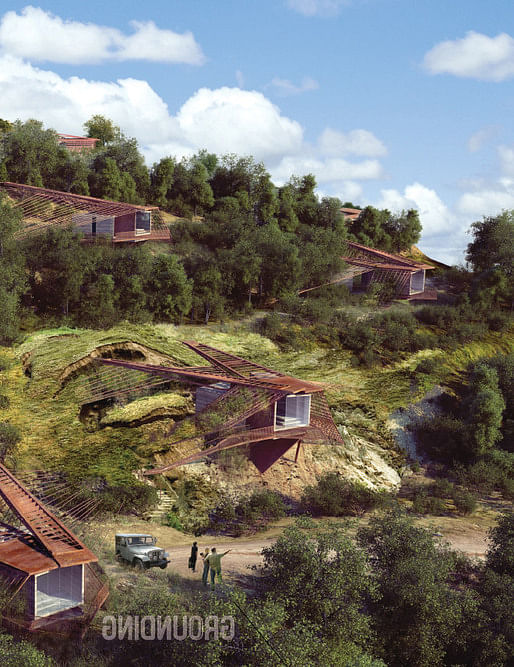
Image: Hillside view. (Rendered in collaboration with Viktor Ramos)
Jared Winchester is a designer based in Albuquerque, New Mexico. He is founder of the architectural studio, Entropic Industries.
Previously featured bracket [GOES SOFT] projects.
3 Comments
Let the earth slide. don't build in land slide areas. another anology to this is seminal article by mike davis, "let malibu burn" meaning don't build in areas where nature has a way of acting up.
While I'm tempted to agree with Orhan, the reality remains that the vision of this project could be cast into the trend of "emergency" architecture that seems to be growing with each natural disaster. With global population rising, we will be forced to continue developing in "hazardous" geographies: earthquake zones, tsunami zones, etc. etc.; so it's certainly encouraging to see attempts at addressing all these issues. The structural credibility of this project cannot be determined from this post, and the anonymity of nature could quickly humiliate the clever adaptive tensile system, but the rigor of the research is present and beautifully diagrammed.
Excited to see more of these!
If we don't build in areas where nature has a way of acting up, we may soon be unable to build anywhere. We would abandon major cities around the world, as well as the rich cultural contributions of these aggregations. I see the benefit of understanding geological forces as one that can help create well-informed structures and advance architecture in a symbiotic way, reducing strain between people and the surrounding ecology. Definitely an interesting project, and the thought is appreciated.
Block this user
Are you sure you want to block this user and hide all related comments throughout the site?
Archinect
This is your first comment on Archinect. Your comment will be visible once approved.